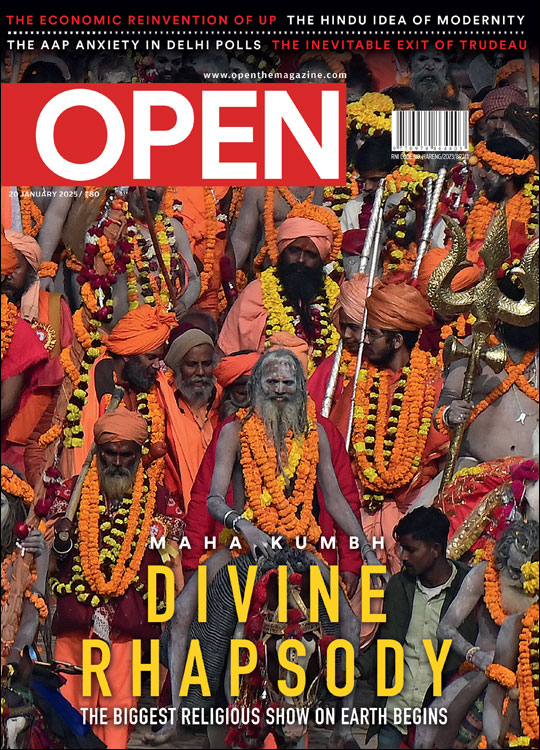/wp-content/uploads/2016/08/Thetrees1.jpg)
SIDEWALKS YOU CAN Walk down on without being jostled; cross walks to take you safely across the road to the neighbourhood bakery; a lush tree-lined avenue with a lineage going back 80 years; sightlines unobstructed by fences or walls and a sense of place like no other. Welcome to The Trees, a mixed-use project, a regenerative renaissance, an evolving campus, a sustainable development, an open source collaborative design journey — all of these and perhaps most importantly a balanced approach to real estate development in Mumbai.
Located near Mumbai’s eastern shoreline, adjacent to the largest preserve of mangroves in the region, the former 34-acre factory complex was envisioned as the first phase of what will pave the way for a mixed- used, vibrant and liveable new district that proactively engages the city. Vikhroli is synonymous with the Godrej group and its uncompromising and unwavering stewardship of the vast tracts of mangroves in its care. As the industry moves away from metropolitan Mumbai, there is a growing realisation that responsible urban transformation of such a green and contiguous land parcel offers Mumbaikars a unique opportunity of city-making at this scale. Appropriately christened ‘The Trees’, the project strives to provide an open and accessible urban setting that regenerates key parts of the site to establish a highly integrated district of residential, commercial, retail, hotel and cultural uses set in a diverse and verdant landscape.
The Trees master plan, developed by Sasaki Associates in collaboration with the GPL Design Studio, was recognised with the Honor Award for thoughtful planning by the Boston Society of Landscape Architects. It is unique in many aspects – creating a distinct image, identity and sense of place through authentic cues from the site’s industrial heritage, building on a landscape created by the founders of the Godrej group and for creating a robust framework that offers different users distinct opportunities for social and cultural exchange in a people-centric and innovation-driven environment. The master plan provides accessibility and linkages to and from adjoining areas, the city, and the larger Mumbai region and aggressively pursues sustainability goals that enhance the liveability of an already green site through pedestrian friendly and climate sensitive green strategies.
The project aims to leverage shared value for infrastructure across asset classes, providing a high quality of place and space while striving to reduce the burden of upkeep on its users. With all assets rated Platinum by IGBC, the development is looking to potentially offer significant savings on the use of resources over its lifecycle for the inhabitants.
The central green spine of existing rain trees that reach over 50 feet in height sets the tone for this highly pedestrian-oriented development. A periphery made of distinct residential enclaves, commercial and hotel buildings surrounds this green heart and central spine to provide a contained inner ‘activated retail park’, with courtyard buildings and walkways. There is a focus on the space between buildings, on creating pedestrian walkways that connect the neighbourhood convenience store, clubhouse, fine dining restaurants set amidst tree canopies, culture spaces and Wi-Fi enabled plazas. The landscape strategy for the project underlines the need for preserving the rain trees and building upon their richness in species, colour and habitus, complimenting the site’s industrial heritage with integrated landscape features.
Verandas and a series of outdoor rooms create courtyard vistas highlighting the view through rain trees by building upon the quality of dappled light, celebrating the entry breezeways, and articulating streetscapes to bring alive the vision for Vikhroli.
The central green spine of rain trees that reach over 50 feet in height sets the tone for this highly pedestrian-oriented development
The master plan is distinctive and the promise of a thoughtfully designed product is matched in equal measure by how its differentiation is demonstrated to the customer. Designed as the experience centre for the project, the Imagine Studio was envisaged as a microcosm of the mixed-use master plan, and as a place- making device within the development. The 3900 SM Imagine Studio complex is an attempt to re-envision the customer journey with a narrative grounded in authenticity while weaving nature, heritage and urbanism through a compelling story of evolving contexts. The collaborative project between Studio Lotus and the GPL Design Studio transformed the small cluster of nondescript industrial buildings and the surrounding landscape into commemorative identities seeped indelibly in the Godrej legacy and yet an invigorating part of its new purpose. The intent was to illustrate an engaged public realm as a microcosm of the master plan while preserving the site’s industrial heritage. Existing buildings and their elements were recycled not only to underline their relevance in the bygone era but also to add meaning as important design punctuations in the narrative. Programmatically, the spaces of the Imagine Studio are adapted into a marketing office, sample flats, meeting spaces, a small café, as well as several outdoor spaces. Two former co-generation plants and a boiler were repurposed to become a studio, workshop and café respectively. A tall chimney redolent of bygone industrial aesthetic stands as a graphic memorial.
THE NEWLY DESIGNED INTERIOR derives inspiration from the memory of the metal silos that occupied the site. Old louvers of the primary plant, now the Studio, were recovered and repurposed in Corten steel and perforated with patterns. The design stimulates the filtering of light from the leafy canopy of rain trees at the site, changing as the day progresses and connecting the spaces to key memories and identities.
Creating the gateway to the entire development with the Studio, the second co-generator plant has been transformed into the workshop. A multi- functional space, it houses sample apartments, a meeting area and a multi- purpose gallery for cultural events such as art shows, talks and performances connecting the development back to the city and its people. The existing boiler plant, between the studio and the workshop buildings, was converted into an all-day café. Coupled with the large chimney, the studio, workshop and boiler café frame a large plaza that’s ideal for activities embodying the project’s positioning of ‘Live. Work. Learn. Play’. The public spaces come alive through events, a market street, an urban farm, an amphitheatre and spaces for art installations.
Sustainability is a key development principle for this project. Salvaged industrial scrap and found objects have been thoughtfully integrated into the landscape. A Corten steel strip inserted into the layout acts as a guiding pathway that subtly indicates the key experiences of the entire experiential journey.
‘Cabinets of Curiosity’, a collaborative art installation by artists Ali Akbar Mehta and Vidha Saumya provides an interesting glimpse into the Godrej group’s history that mirrors nation-building and is depicted through the past, present and future within the silos clustered inside the legacy park.
The Trees offers an integrated district of residential, commercial, retail, hotel and cultural uses set in a verdant landscape.
The sample apartments at The Trees are thoughtfully curated by the GPL Design Studio to experientially imagine life in the development. The narrative is based on demographic research carefully woven into storytelling across various touch points for both the three- and one-bed apartments. Evoking the idea of a family for homeowners with distinct personalities who have chosen to make a home here, the experience begins when the viewer walks in and interrupts a regular day in the family’s life whose preferences and personalities in homemaking can be felt but seem just out of sight. As the observer journeys through the rooms, a number of sensory stimuli tickle their imagination to create associations and aspirations that assist in making the spaces their own, imbuing the experience with a powerful personal narrative.
The Studio has experimented with various innovative ideas to make for brighter and better living at The Trees. Based on direct feedback and from sales velocities achieved during the launch (the project was 75 per cent sold out in the first three days of launch), it appears that customers appreciated this thoughtful approach.
For Godrej Properties, luxury is a state of design and experience, which is most effectively captured in their approach predicated on elegance, simplicity and the quiet pleasures that evoke a ‘luxe life’, delineated in texture, clean lines and a minimalist palette. It uses flat slab construction to avoid beam drops and allow for clean volumes and purity of space; limits columns to the periphery of apartments creating flexibility in configuring interiors, and provides floor- to-ceiling glazing to maximise day- lighting, views and natural ventilation. The larger units come with a double skin balcony that can be used as a conservatory or as an extension of the living room for additional space. The one-bedroom units are cleverly and flexibly planned to maximise the use and perception of space for the available carpet area. The units have a large bathroom and the option to have a semi-open kitchen, which was much appreciated by the customers.
Market feedback revealed that the majority of customers purchased their homes for end use, a big testament for the success of both the experiential and functional innovations that the integrated design thinking has brought to The Trees. A narrative is a very powerful device not only to tell stories but also to inspire place-making and design inception itself. Success in prototyping the Imagine Studio influenced the design evolution of another asset in the master plan, the bespoke clubhouse. The memory of an old glycerine plant with distinctive proportions situated elsewhere in the campus is invoked in the multipurpose clubhouse hall, which is nestled within a grove. The materials speak an industrial language and the clubhouse building appears to be a complex of found objects in an erstwhile industrial landscape. Boundaries are blurred between the real and the unreal as far as found objects go; layers have been added to stories, and the narrative has inspired the design. The development journey for the project offers an interesting insight into the mechanisms of value creation in real estate. The Trees is Godrej Properties’ flagship project and its success can be attributed in large measure to the clear and deliberate focus on design across scales from master planning to innovations at the dwelling level. The narrative of ‘Imagine Life in the Trees,’ has consistently influenced the project’s positioning and product strategy, design, visual identity, place making, marketing communication, and customer outreach strategy in one seamless narrative.
BUT NARRATIVES NEED INCEPTION and nurturing for delivery across design, product development, and marketing strategy. The emphasis on design in real estate development is not new, but this isn’t just about the inevitable aesthetic layers or unique selling points that are tacked on at the end. What makes The Trees unique as a project is the cohesive strategy underlying its development journey, the partners that are a part of it, and a unique co-creation, co-ideation design format prototyped by a creative studio housed in a developer setting – the GPL Design Studio.
“For the GPL Design Studio, tasked with product development and the creation of customer experiences for Godrej Properties’ 11.89 million square meters pan-India portfolio, design is not a business vertical, it is a business horizontal,” says Anubhav Gupta, Chief Design Officer for the company, crediting a design thinking non-linear approach for the project’s success.
Gupta says, “Innovation is not about playing it safe; one needs to have an appetite for risk and an ability to tolerate failure before getting to superlative success.” He adds, “Owing to the tremendous success of The Trees, Vikhroli is all set to evolve into one of India’s most vibrant mixed-use districts over time.” Brad Perkins, owner of Perkins Eastman, one of the world’s largest international design firms and co- creator of the first phase of residential development at The Trees says, “Godrej Properties have always been committed to design excellence. We are very proud of the design for The Trees, which resulted from a close collaboration with a client seeking excellence”.
Dennis Pieprz, partner at Sasaki Associates that co-authored the award- winning master plan with GPL Design Studio, says, “The Trees carefully intertwines culture, technology, history, and landscape. The master plan creates a strong sense of place and embodies Godrej’s culture and way of thinking, which are synonymous with quality and a collective consciousness for sustainability”.
(Advertiser Sponsored Feature – a marketing initiative.)

/wp-content/uploads/2025/01/Cover_Kumbh.jpg)











More Columns
The lament of a blue-suited social media platform Chindu Sreedharan
Pixxel launches India’s first private commercial satellite constellation V Shoba
What does the launch of a new political party with radical background mean for Punjab? Rahul Pandita